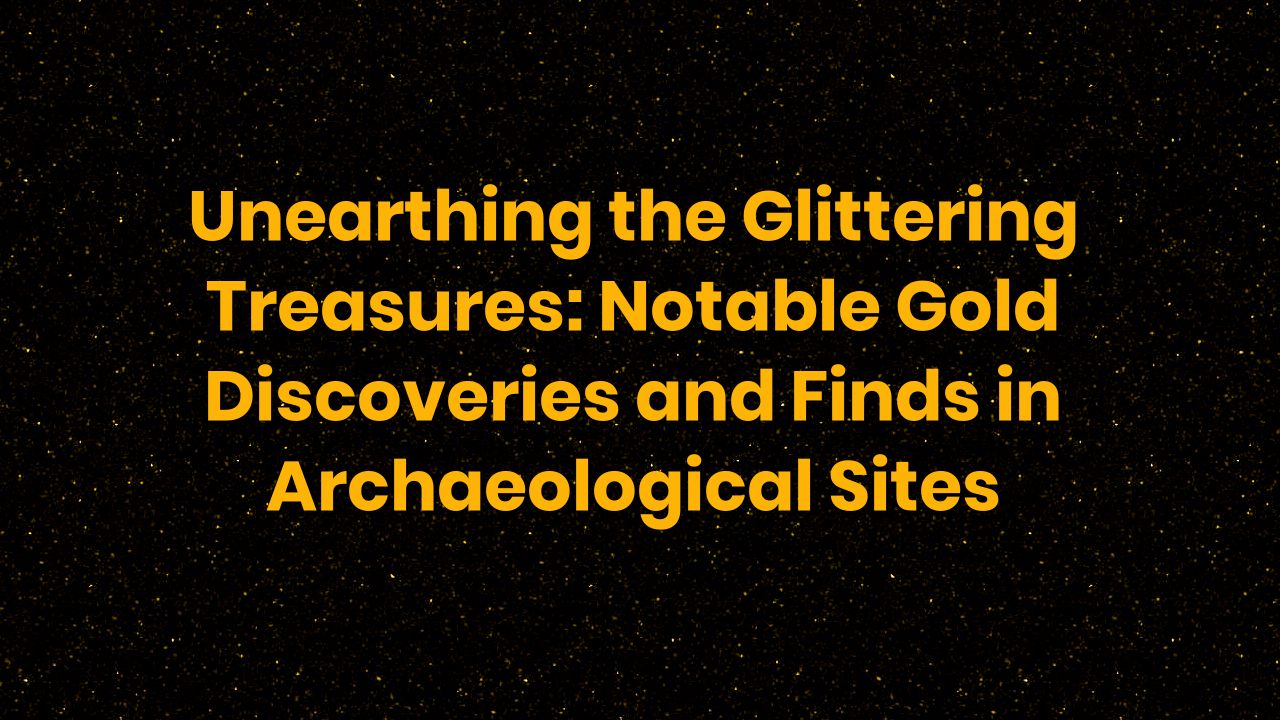
Table of Contents
Introduction: The Allure of Gold in Archaeology
Gold has always been one of the most beloved and sought-after metals in human culture. As a symbol of wealth, power, and beauty, it has played a significant role in many historical societies – from the Ancient Egyptians and Greeks to the Moche of South America. Archaeologists have been fascinated by gold since the dawn of their profession, and many of the most significant archaeological finds in history have been gold treasures. This blog will take you on a journey to some of the most notable gold discoveries and finds in archaeological sites.
The Extravagant Gold Treasures of Sipán, Peru
The discovery of the Lord of Sipán’s tomb by Peruvian archaeologist Walter Alva in 1987 was a groundbreaking event in the history of archaeology. The Moche nobleman was buried between AD 300 and 700 wearing an array of golden ornaments, including a dazzling headdress with a gold image of a warrior and a pair of elaborate golden ear spools. The tomb also contained numerous ceremonial items made of gold, silver, and copper. The discovery of the Lord of Sipán’s tomb changed the perception of Moche culture and revealed the great wealth and sophistication of this ancient civilization.
The Ancient Wealth of the Golden Grave of Sremska Mitrovica
The Golden Grave of Sremska Mitrovica, discovered in Northern Serbia in 1953, is one of the most magnificent archaeological finds in Europe. The grave contained the remains of a wealthy Celt buried with an array of luxurious items, including a stunning gold torc (neck-ring) and an intricate gold belt. The finds indicated the existence of a powerful and wealthy Celtic elite in the region, which had long been thought to be a cultural backwater.
The Imperial Golden Pendant of the Maikop Culture
The Maikop Culture was an ancient civilization that flourished in the Caucasus region between the 36th and 20th centuries BC. One of the most spectacular finds from this culture is the Golden Pendant of the Maikop King or Queen. The pendant, discovered in a royal tomb in 1954, is crafted from solid gold and weighs over 900 grams. The pendant is adorned with intricate designs and motifs, including a lion, a bull, and birds. The pendant is believed to have been a sign of royal authority, and its discovery shed new light on the ancient cultures of the region.
The Thracian Golden Hoard of Panagyurishte
The Thracian Golden Hoard of Panagyurishte is a collection of gold vessels discovered in Bulgaria in 1949. The hoard consists of nine vessels weighing over six kilograms and intricately decorated with mythological scenes and elaborate patterns. The hoard was buried in the 4th century BC, during a time of political and social instability in the region, and its discovery provides evidence of the wealth and sophistication of the Thracian culture.
The Majestic Golden Helmet of King Tutankhamun
The tomb of King Tutankhamun, discovered by Howard Carter in Egypt in 1922, contained many spectacular treasures, including the famous Golden Mask of Tutankhamun. However, one of the most remarkable finds in the tomb was the Golden Helmet of Tutankhamun. The helmet, made of solid gold, is exquisitely crafted in the shape of the god Sekhmet, with the king’s head forming the god’s face. The helmet was worn by the young pharaoh in battle, and its discovery shed new light on the military prowess of the ancient Egyptians.
The Enigmatic Gold Treasure of the Moche Culture
The Moche civilization of Peru is famous for its extravagant gold ornaments, and the discovery of the Gold Treasure of the Lord of Sipán in 1987 was a crowning achievement of Peruvian archaeology. The treasure, discovered in a tomb near the city of Lambayeque, consists of more than 400 gold, silver, and copper objects, including a golden scepter, a golden mask, and several golden vessels. The intricate details of the treasures and the quality of their construction attest to the supreme technical and artistic skills of the Moche craftsmen.
The Mystical Golden Funerary Mask of King Agamemnon
The Golden Funerary Mask of King Agamemnon, discovered by Heinrich Schliemann in the ancient city of Mycenae in 1876, is one of the most iconic images of ancient Greece. The mask, crafted in gold and decorated with intricate patterns, was originally believed to represent the mythical hero Agamemnon. However, modern analyses of the mask indicate that it may date from an earlier period and may represent another important Mycenaean ruler.
The Sparkling Archaeological Heritage of the Gold Museum in Bogota
The Gold Museum (El Museo del Oro) in Bogota, Colombia, is home to one of the most extensive collections of pre-Columbian gold artifacts in the world. The museum’s collection includes more than 55,000 pieces, including ceremonial objects, jewelry, and ornaments, made by indigenous cultures from all over Colombia. The museum is a testament to the rich and diverse cultural heritage of Colombia and a reminder of the great value placed on gold by the indigenous people of the region.
The Tragic Fate of the Golden Sun of the Incas
The Golden Sun of the Incas was a gold disc with precious stones, representing the Inca sun god Inti, and was one of the most important religious artifacts of the Inca Empire. The Sun of the Incas was taken by the Spanish conquistadors during the Conquest of Peru in the 16th century and was melted down into bullion. The loss of this unique and precious artifact is a reminder of the tragic impact of colonization on indigenous peoples and cultures.
Conclusion: The Eternal Quest for Gold in Archaeological Sites
The search for gold has played a vital role in human history and remains one of the most significant pursuits of civilization. The allure of gold has driven the creation of many of the most extraordinary archaeological treasures in the world, from the Moche of South America to the Maikop of the Caucasus. These treasures are a testament to human creativity, ambition, and ingenuity, and they provide us with a glimpse of the wealth and power that once existed in ancient societies.





